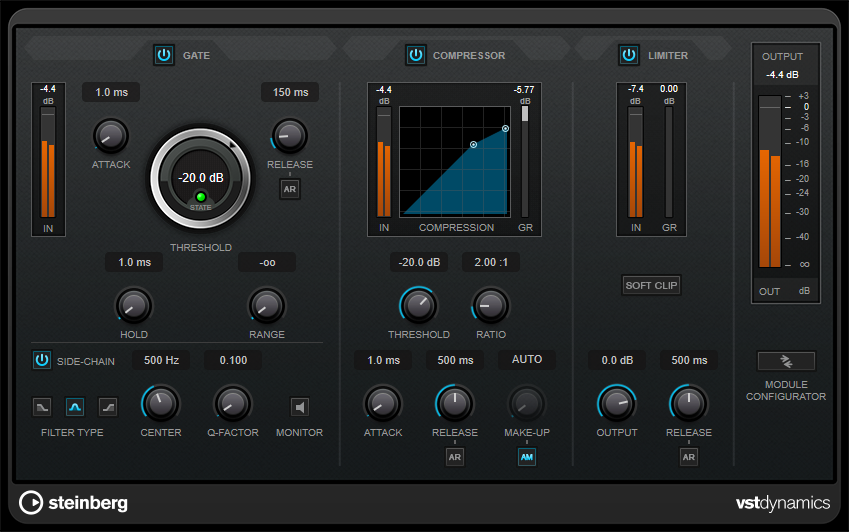VSTDynamics
VSTDynamics is an advanced dynamics processor. It combines three separate effects: Gate, Compressor, and Limiter, covering a variety of dynamic processing functions.
|
Cubase LE |
Cubase AI |
Cubase Elements |
Cubase Artist |
Cubase Pro |
Nuendo |
|
|---|---|---|---|---|---|---|
|
Included with |
X |
X |
X |
X |
X |
X |

The window is divided into three sections containing controls and meters for each effect. Activate the individual effects using the Gate, Compressor, and Limiter buttons. You can select between three different routing options using the Module Configurator button.
Gate
Gating, or noise gating, is a method of dynamic processing that silences audio signals below a set threshold. As soon as the signal level exceeds the threshold, the gate opens to let the signal through. The gate trigger input can also be filtered using an internal side-chain signal.
The following parameters are available:
- Input meter
-
Shows the level of the input signal.
- Attack (0.1 to 100 ms)
Determines how fast the compressor responds to signals above the set threshold. If the attack time is long, more of the early part of the signal passes through unprocessed.
- Threshold (-60 to 0 dB)
Determines the level at which the gate is activated. Signal levels above the set threshold trigger the gate to open, and signal levels below the set threshold close the gate.
- State LED
Indicates whether the gate is open (LED lights up in green), closed (LED lights up in red), or in an intermediate state (LED lights up in yellow).
- Release (10 to 1000 ms or Auto mode)
Sets the time after which the gate closes after the set Hold time. If Auto Release is activated, the plug-in automatically finds the best release setting for the audio material.
- Hold (0 to 2000 ms)
Determines how long the gate remains open after the signal drops below the threshold level.
- Range
Adjusts the attenuation of the gate when it is shut. If Range is set to minus infinite
 , the gate is completely shut. The higher the value, the higher the level of the signal that passes through the shut gate.
, the gate is completely shut. The higher the value, the higher the level of the signal that passes through the shut gate.- Side-Chain
Activates the internal side-chain filter. The input signal can then be shaped according to the filter parameters. Internal side-chaining is useful for tailoring how the gate operates.
- Filter Type (Low-Pass/Band-Pass/High-Pass)
If Side-Chain is activated, these buttons allow you to set the filter type to low-pass, band-pass, or high-pass.
- Center (50 to 20000 Hz)
If the Side-Chain button is activated, this sets the center frequency of the filter.
- Q-Factor
If the Side-Chain button is activated, this sets the resonance or width of the filter.
- Monitor
Allows you to monitor the filtered signal.
Compressor
Compressor reduces the dynamic range of the audio, making softer sounds louder or louder sounds softer, or both. It features a separate display that graphically illustrates the compressor curve shaped according to your settings.
- Input meter
-
Shows the level of the input signal.
- Graphical display
-
Visualizes the settings for Threshold and Ratio and allows you to adjust them by dragging the handles.
- Gain Reduction meter
-
Shows the amount of gain reduction.
- Threshold (-60 to 0 dB)
Determines the level where the compressor kicks in. Only signal levels above the set threshold are processed.
- Ratio
Sets the amount of gain reduction applied to signals above the set threshold. A ratio of 3:1 means that for every 3 dB the input level increases, the output level increases by 1 dB.
- Make-Up (0 to 24 dB or Auto mode)
Compensates for output gain loss caused by compression. If Auto Make-Up Gain is activated, the output is automatically adjusted for gain loss.
- Attack (0.1 to 100 ms)
Determines how fast the compressor responds to signals above the set threshold. If the attack time is long, more of the early part of the signal (attack) passes through unprocessed.
- Release (10 to 1000 ms or Auto mode)
Sets the time after which the gain returns to its original level when the signal drops below the threshold. If Auto Release is activated, the plug-in automatically finds the best release setting for the audio material.
Limiter
A limiter ensures that the output level never exceeds a set threshold to avoid clipping in effects following in the chain. Conventional limiters usually require a very accurate setup of the attack and release parameters to prevent the output level from going beyond the set threshold level. Limiter adjusts and optimizes these parameters automatically according to the audio material.
- Input meter
-
Shows the level of the input signal.
- Gain Reduction meter
-
Shows the amount of gain reduction.
- Soft Clip
If this button is activated, the signal is limited when the signal level exceeds -6 dB. At the same time, harmonics are generated, adding a warm, tube-like characteristic to the audio material.
- Output
Sets the maximum output level.
- Release (10 to 1000 ms or Auto mode)
Sets the time after which the gain returns to its original level. If Auto Release is activated, the plug-in automatically finds the best release setting for the audio material.
Output section
- Output meter
Shows the level of the output signal.
- Module Configurator
-
Changes the signal flow through the three effects. Changing the order of the effects can produce different results, and the available routing configurations allow you to quickly compare what works best for a given situation. Click Module Configurator to toggle between the following routing configurations:
-
G-C-L (Gate-Compressor-Limiter)
-
C-L-G (Compressor-Limiter-Gate)
C-G-L (Compressor-Gate-Limiter)